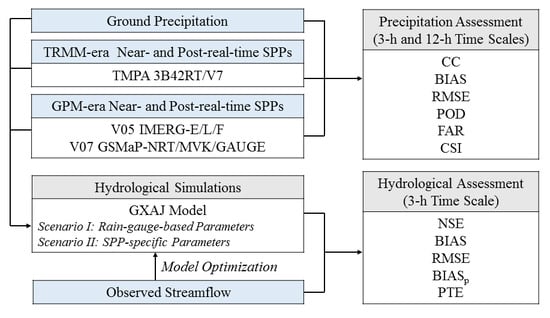Applications of TRMM- and GPM-Era Multiple-Satellite Precipitation Products for Flood Simulations at Sub-Daily Scales in a Sparsely Gauged Watershed in Myanmar
Abstract
1. Introduction
- (1)
- statistically assess and compare the accuracy of the latest GPM-era IMERG (IMERG-E, IMERG-L, and IMERG-F) and GSMaP (GSMaP-NRT, GSMaP-MVK, and GSMaP-GAUGE) SPPs with that of the TRMM-era TMPA SPPs (3B42RT and 3B42V7) at sub-daily time scales (3 h for daytime precipitation estimates and 12 h for nighttime precipitation retrievals) in the study area; and
- (2)
- comprehensively assess the hydrological performance of the latest GPM-era SPPs in simulating historical discharge processes at 3-h temporal scales in comparison with TMPA SPPs.
2. Study Area and Data Processing
2.1. Study Area
2.2. Ground Weather Data
2.3. Satellite Precipitation Data
2.3.1. TMPA Version 7 Products
2.3.2. IMERG Version 05B Products
2.3.3. GSMaP Version 07 Products
2.3.4. Spatial Distribution of Total Precipitation from SPPs and Gauge-Based Precipitation Data
2.4. Discharge Data
3. Methodology
3.1. Evaluation Statistics
3.2. Grid-Based Xinanjiang Hydrological Model
3.3. Discharge Simulations Using Multiple Precipitation Data Sets under Two Model Setup Scenarios
4. Results
4.1. Statistical Assessment of Multiple SPPs
4.1.1. Precipitation at Gauge-Located Grid Cells
4.1.2. Watershed-Averaged Precipitation
4.2. Assessment of Discharge Simulations Using Multiple SPPs
4.2.1. Scenario I: Discharge Simulations with Rain-Gauge-Calibrated Parameters
4.2.2. Scenario II: Discharge Simulations with Satellite-product-specific Parameters
4.2.3. Effects of Product-Specific Model Recalibration on Flood Simulations
5. Discussion
5.1. Evaluation of SPPs against Ground Rainfall Observations
5.2. Evaluation of Hydrological Performance of the GPM-Era SPPs
6. Conclusions
- (1)
- Statistical assessment at grid and basin scales demonstrates that 3B42RT generally presents a higher quality, followed by IMERG-F and 3B42V7. IMERG-E, IMERG-L, GSMaP-NRT, GSMaP-MVK, and GSMaP-GAUGE obviously underestimate total precipitation, and the three GSMaP SPPs have the lowest accuracy.
- (2)
- Given that 3B42RT demonstrates the best quality among the four near-real-time SPPs, 3B42RT obtains satisfactory hydrological ability (NSE = 0.871) in 3-hourly streamflow simulations using the rain-gauge-benchmarked parameters, which is comparable with the rain-gauge-based precipitation data (NSE = 0.895). Although 3B42V7 and IMERG-F have comparatively better quality than the other two post-real-time SPPs, these two SPPs have mildly poorer hydrological performance (NSE = 0.690 and 0.664 for 3B42V7 and IMERG-F, respectively).
- (3)
- The input-specific model recalibration greatly improves the SPP-based streamflow simulations. 3B42RT obtains good hydrological performance (NSE = 0.868). Following 3B42RT, IMERG-F (NSE = 0.840) slightly outperforms 3B42V7 (NSE = 0.828).
Supplementary Materials
Author Contributions
Funding
Acknowledgments
Conflicts of Interest
References
- Hou, A.Y.; Kakar, R.K.; Neeck, S.; Azarbarzin, A.A.; Kummerow, C.D.; Kojima, M.; Oki, R.; Nakamura, K.; Iguchi, T. The global precipitation measurement mission. Bull. Am. Meteorol. Soc. 2014, 95, 701–722. [Google Scholar] [CrossRef]
- Huffman, G.J.; Bolvin, D.T.; Nelkin, E.J.; Wolff, D.B.; Adler, R.F.; Gu, G.; Hong, Y.; Bowman, K.P.; Stocker, E.F. The TRMM multisatellite precipitation analysis (TMPA): Quasi-global, multiyear, combined-sensor precipitation estimates at fine scales. J. Hydrometeorol. 2007, 8, 38–55. [Google Scholar] [CrossRef]
- Hsu, K.; Gao, X.; Sorooshian, S.; Gupta, H.V. Precipitation estimation from remotely sensed information using artificial neural networks. J. Appl. Meteorol. 1997, 36, 1176–1190. [Google Scholar] [CrossRef]
- Joyce, R.J.; Janowiak, J.E.; Arkin, P.A.; Xie, P. CMORPH: A method that produces global precipitation estimates from passive microwave and infrared data at high spatial and temporal resolution. J. Hydrometeorol. 2004, 5, 487–503. [Google Scholar] [CrossRef]
- Chris, F.; Peterson, P.; Landsfeld, M.; Pedreros, D.; Verdin, J.; Shukla, S.; Husak, G.; Rowland, J.; Harrison, L.; Hoell, A.; et al. The climate hazards infrared precipitation with stations—A new environmental record for monitoring extremes. Sci. Data 2015, 2, 150066. [Google Scholar]
- Kubota, T.; Shige, S.; Hashizume, H.; Aonashi, K.; Takahashi, N.; Seto, S.; Hirose, M.; Takayabu, Y.N.; Ushio, T.; Nakagawa, K.; et al. Global precipitation map using satellite-borne microwave radiometers by the GSMaP project: Production and validation. IEEE Trans. Geosci. Remote Sens. Lett. 2007, 45, 2259–2275. [Google Scholar] [CrossRef]
- Falck, A.S.; Maggioni, V.; Tomasella, J.; Vila, D.A.; Diniz, F.L.R. Propagation of satellite precipitation uncertainties through a distributed hydrologic model: A case study in the Tocantins–Araguaia basin in Brazil. J. Hydrol. 2015, 527, 943–957. [Google Scholar] [CrossRef]
- Qi, W.; Zhang, C.; Fu, G.; Sweetapple, C.; Zhou, H. Evaluation of global fine-resolution precipitation products and their uncertainty quantification in ensemble discharge simulations. Hydrol. Earth Syst. Sci. 2016, 20, 903–920. [Google Scholar] [CrossRef]
- Yoshimoto, S.; Amarnath, G. Applications of Satellite-Based Rainfall Estimates in Flood Inundation Modeling—A Case Study in Mundeni Aru River Basin, Sri Lanka. Remote Sens. 2017, 9, 998. [Google Scholar] [CrossRef]
- Saber, M.; Yilmaz, K.K. Evaluation and Bias Correction of Satellite-Based Rainfall Estimates for Modelling Flash Floods over the Mediterranean region: Application to Karpuz River Basin, Turkey. Water 2018, 10, 657. [Google Scholar] [CrossRef]
- Jiang, S.H.; Ren, L.L.; Hong, Y.; Yang, X.L.; Yuan, F.; Ma, M.W. Comprehensive evaluation of multi-satellite precipitation products with a dense rain gauge network and optimally merging their simulated hydrological flows using the bayesian model averaging method. J. Hydrol. 2012, 452–453, 213–225. [Google Scholar] [CrossRef]
- Nikolopoulos, E.I.; Anagnostou, E.N.; Borga, M. Using High-resolution Satellite Rainfall Products to Simulate a Major Flash Flood Event in Northern Italy. J. Hydrometeorol. 2013, 14, 171–185. [Google Scholar] [CrossRef]
- Tuo, Y.; Duan, Z.; Disse, M. Evaluation of precipitation input for SWAT modeling in Alpine catchment: A case study in the Adige river basin (Italy). Sci. Total Environ. 2016, 573, 66–82. [Google Scholar] [CrossRef] [PubMed]
- Ciabatta, L.; Brocca, L.; Massari, C. Rainfall-runoff modelling by using SM2RAIN-derived and state-of-the-art satellite rainfall products over Italy. Int. J. Appl. Earth Obs. 2016, 48, 163–173. [Google Scholar] [CrossRef]
- Behrangi, A.; Khakbaz, B.; Jaw, T.C.; AghaKouchak, A.; Hsu, K.; Sorooshian, S. Hydrologic evaluation of satellite precipitation products over a mid-size basin. J. Hydrol. 2011, 397, 225–237. [Google Scholar] [CrossRef]
- Tarnavsky, E.; Mulligan, M.; Ouessar, M.; Faye, A.; Black, E. Dynamic hydrological modeling in drylands with TRMM based rainfall. Remote Sens. 2013, 5, 6691–6716. [Google Scholar] [CrossRef]
- Hong, Y.; Adler, R.; Huffman, G. Applications of TRMM-based multi-satellite precipitation estimation for global runoff simulation: Prototyping a global flood monitoring system. In Satellite Rainfall Applications for Surface Hydrology, 1st ed.; Gebremichael, M., Hossain, F., Eds.; Springer: Dordrecht, The Netherlands, 2010; pp. 245–265. [Google Scholar]
- Yong, B.; Ren, L.-L.; Hong, Y.; Wang, J.-H.; Gourley, J.J.; Jiang, S.-H.; Chen, X.; Wang, W. Hydrologic evaluation of Multisatellite Precipitation Analysis standard precipitation products in basins beyond its inclined latitude band: A case study in Laohahe basin, China. Water Resour. Res. 2010, 46, W07542. [Google Scholar] [CrossRef]
- Xue, X.; Hong, Y.; Limaye, A.S.; Gourley, J.J.; Huffman, G.J.; Khan, S.I.; Dorji, C.; Chen, S. Statistical and hydrological evaluation of TRMM-based multi-satellite precipitation analysis over the Wangchu basin of Bhutan: Are the latest satellite precipitation products 3B42V7 ready for use in ungauged basins? J. Hydrol. 2013, 499, 91–99. [Google Scholar] [CrossRef]
- Behrangi, A.; Andreadis, K.; Fisher, J.B. Satellite-based precipitation estimation and its application for streamflow prediction over mountainous western US basins. J. Appl. Meteorol. Clim. 2014, 53, 2823–2842. [Google Scholar] [CrossRef]
- Tobin, K.J.; Bennett, M.E. Temporal analysis of Soil and Water Assessment Tool (SWAT) performance based on remotely sensed precipitation products. Hydrol. Process. 2013, 27, 505–514. [Google Scholar] [CrossRef]
- Tong, K.; Su, F.; Yang, D.; Hao, Z. Evaluation of satellite precipitation retrievals and their potential utilities in hydrologic modeling over the Tibetan Plateau. J. Hydrol. 2014, 519, 423–437. [Google Scholar] [CrossRef]
- Su, F.; Hong, Y.; Lettenmaier, D.P. Evaluation of TRMM Multisatellite Precipitation Analysis (TMPA) and its utility in hydrologic prediction in the La Plata basin. J. Hydrometeorol. 2008, 9, 622–640. [Google Scholar] [CrossRef]
- Wang, Z.; Zhong, R.; Lai, C.; Chen, J. Evaluation of the GPM IMERG satellite-based precipitation products and the hydrological utility. Atmos. Res. 2017, 196, 151–163. [Google Scholar] [CrossRef]
- Jiang, S.; Ren, L.; Xu, C.; Yong, B.; Yuan, F.; Liu, Y.; Yang, X. Statistical and hydrological evaluation of the latest Integrated Multi-satellitE Retrievals for GPM (IMERG) over a midlatitude humid basin in South China. Atmos. Res. 2018, 214, 418–429. [Google Scholar] [CrossRef]
- Huffman, G.J.; Bolvin, D.T.; Dan, B.; Hsu, K.; Joyce, R.; Kidd, C.; Nelkin, E.J.; Sorooshian, S.; Tan, J.; Xie, P. Algorithm Theoretical Basis Document (ATBD) Version 5.2 NASA Global Precipitation Measurement (GPM) Integrated Multi-satellitE Retrievals for GPM (IMERG); NASA/GSFC: Greenbelt, MD, USA, 2018.
- Tan, J.; Peterson, W.A.; Kirstetter, P.E.; Tian, Y. Performance of IMERG as a function of spatiotemporal scale. J. Hydrometeorol. 2017, 18, 307–319. [Google Scholar] [CrossRef] [PubMed]
- Gebregiorgis, A.S.; Kirstetter, P.E.; Hong, Y.; Gourley, J.J.; Huffman, G.J.; Peterson, W.A.; Xue, X.W.; Schwaller, M.R. To what extent is the day 1 GPM IMERG satellite precipitation estimate improved as compared to TRMM TMPA-RT? J. Geophys. Res. Atmos. 2018, 123, 1694–1707. [Google Scholar] [CrossRef]
- Rozante, J.R.; Vila, D.A.; Chiquetto, J.B.; Fernandes, A.A.; Alvim, D.S. Evaluation of TRMM/GPM Blended Daily Products over Brazil. Remote Sens. 2018, 10, 882. [Google Scholar] [CrossRef]
- Dezfuli, A.K.; Ichoku, C.M.; Mohr, K.I.; Huffman, G.J. Precipitation characteristics in West and East Africa from satellite and in situ observations. J. Hydrometeorol. 2017, 18, 1799–1805. [Google Scholar] [CrossRef]
- Anjum, M.N.; Ding, Y.J.; Shangguan, D.H.; Ahmad, L.; Ijaz, M.W.; Faird, H.U.; Yagoub, Y.E.; Zaman, M.; Adnan, M. Performance evaluation of latest integrated multi-satellite retrievals for global precipitation measurement (IMERG) over the northern highlands of Pakistan. Atmos. Res. 2018, 205, 134–146. [Google Scholar] [CrossRef]
- Tan, M.L.; Harrif, S. Comparison of GPM IMERG, TMPA 3B42 and PERSIANN-CDR satellite precipitation products over Malaysia. Atmos. Res. 2018, 203, 63–76. [Google Scholar] [CrossRef]
- Prakash, S.; Mitra, A.K.; Pai, D.S.; AghaKouchak, A. From TRMM to GPM: How well can heavy rainfall be detected from space? Adv. Water Resour. 2016, 88, 1–7. [Google Scholar] [CrossRef]
- Prakash, S.; Mitra, A.K.; AghaKouchak, A. A preliminary assessment of GPM-based multi-satellite precipitation estimates over a monsoon dominated region. J. Hydrol. 2018, 556, 865–876. [Google Scholar] [CrossRef]
- Wang, W.; Lu, H.; Zhao, T.; Jiang, L.; Shi, J. Evaluation and comparison of daily rainfall from latest GPM and TRMM products over the Mekong River basin. IEEE J. Sel. Top. Appl. Earth Obs. Remote Sens. 2017, 10, 2540–2549. [Google Scholar] [CrossRef]
- He, Z.; Yang, L.; Tian, F.; Ni, G.; Hou, A.; Lu, H. Intercomparisons of rainfall estimates for TRMM and GPM multisatellite products over the upper Mekong River basin. J. Hydrometeorol. 2017, 18, 413–430. [Google Scholar] [CrossRef]
- Sharifi, E.; Steinacker, R.; Saghafian, B. Assessment of GPM-IMERG and other precipitation products against gauge data under different topographic and climatic conditions in Iran: Preliminary results. Remote Sens. 2016, 8, 135. [Google Scholar] [CrossRef]
- Siuki, S.K.; Saghafian, B.; Moazami, S. Comprehensive evaluation of 3-hourly TRMM and half-hourly GPM-IMERG satellite precipitation products. Int. J. Remote Sens. 2017, 38, 558–571. [Google Scholar] [CrossRef]
- Kim, K.; Park, J.; Baik, J.; Choi, M. Evaluation of topographical and seasonal feature using GPM IMERG and TRMM 3B42 over Far-east Asia. Atmos. Res. 2017, 187, 95–105. [Google Scholar] [CrossRef]
- Tang, G.; Ma, Y.; Long, D.; Zhong, L.; Hong, Y. Evaluation of GPM Day-1 IMERG and TMPA Version-7 legacy products over Mainland China at multiple spatiotemporal scales. J. Hydrol. 2016, 533, 152–167. [Google Scholar] [CrossRef]
- Guo, H.; Chen, S.; Bao, A.; Behrangi, A.; Hong, Y.; Ndayisaba, F.; Hu, J.; Stepanian, P.M. Early assessment of Integrated Multi-satellite Retrievals for Global Precipitation Measurement over China. Atmos. Res. 2016, 176–177, 121–133. [Google Scholar] [CrossRef]
- Ma, Y.; Tang, G.; Long, D.; Yong, B.; Zhong, L.; Wan, W.; Hong, Y. Similarity and error intercomparison of the GPM and its predecessor-TRMM multisatellite precipitation analysis using the best available hourly gauge network over the Tibetan Plateau. Remote Sens. 2016, 8, 569. [Google Scholar] [CrossRef]
- Xu, R.; Tian, F.; Yang, L.; Hu, H.; Lu, H.; Hou, A. Ground validation of GPM IMERG and TRMM 3B42V7 rainfall products over southern Tibetan Plateau based on a high-density rain gauge network. J. Geophys. Res. Atmos. 2017, 122, 910–924. [Google Scholar] [CrossRef]
- Yuan, F.; Wang, B.; Shi, C.; Cui, W.; Zhao, C.; Liu, Y.; Ren, L.; Zhang, L.; Zhu, Y.; Chen, T.; et al. Evaluation of hydrological utility of IMERG Final run V05 and TMPA 3B42V7 satellite precipitation products in the Yellow River source region, China. J. Hydrol. 2018, 567, 696–711. [Google Scholar] [CrossRef]
- Tang, G.; Zeng, Z.; Long, D.; Guo, X.; Yong, B.; Zhang, W.; Hong, Y. Statistical and hydrological homparison between TRMM and GPM level-3 products over a midlatitude basin: Is Day-1 IMERG a good successor of TMPA 3B42V7? J. Hydrometeorol. 2016, 17, 121–137. [Google Scholar] [CrossRef]
- Li, N.; Tang, G.; Zhao, P.; Hong, Y.; Gou, Y.; Yang, K. Statistical assessment and hydrological utility of the latest multi-satellite precipitation analysis IMERG in Ganjiang River basin. Atmos. Res. 2017, 183, 212–223. [Google Scholar] [CrossRef]
- Yuan, F.; Zhang, L.; Win, K.W.W.; Ren, L.; Zhao, C.; Zhu, Y.; Jiang, S.; Liu, Y. Assessment of GPM and TRMM multi-satellite precipitation products in streamflow simulations in a data-sparse mountainous watershed in Myanmar. Remote Sens. 2017, 9, 302. [Google Scholar] [CrossRef]
- Zubieta, R.; Getirana, A.; Espinoza, J.C.; Lavado-Casimiro, W.; Aragon, L. Hydrological modeling of the Peruvian-Ecuadorian Amazon Basin using GPM-IMERG satellite-based precipitation dataset. Hydrol. Earth Syst. Sci. 2017, 21, 3543–3555. [Google Scholar] [CrossRef]
- Sharif, H.O.; Al-Zahrani, M.; Hassan, A.E. Physically, fully-distributed hydrological simulations driven by GPM satellite rainfall over an urbanizing arid catchment in Saudi Arabia. Water 2017, 9, 163. [Google Scholar] [CrossRef]
- Tan, M.L.; Samat, N.; Chan, N.W.; Roy, R. Hydro-Meteorological Assessment of Three GPM Satellite Precipitation Products in the Kelantan River Basin, Malaysia. Remote Sens. 2018, 10, 1011. [Google Scholar] [CrossRef]
- Saber, M.; Hamaguchi, T.; Kojiri, T.; Tanaka, K.; Sumi, T. A physically based distributed hydrological model of wadi system to simulate flash floods in arid regions. Arab. J. Geosci. 2015, 8, 143–160. [Google Scholar] [CrossRef]
- Ryo, M.; Valeriano, O.C.S.; Kanae, S.; Ngoc, T.D. Temporal Downscaling of Daily Gauged Precipitation by Application of a Satellite Product for Flood Simulation in a Poorly Gauged Basin and Its Evaluation with Multiple Regression Analysis. J. Hydrometeorol. 2014, 15, 563–580. [Google Scholar] [CrossRef]
- Shahzad, A.S.; Gabriel, H.F.; Haider, S.; Mubeen, A.; Siddiqui, M.J. Development of a flood forecasting system using IFAS: A case study of scarcely gauged Jhelum and Chenab river basins. Arab. J. Geosci. 2018, 11, 383. [Google Scholar] [CrossRef]
- Sugiura, A.; Fujioka, S.; Nabesaka, S.; Tsuda, M.; Iwami, Y. Development of a flood forecasting system on the upper Indus catchment using IFAS. J. Flood Risk Manag. 2016, 9, 265–277. [Google Scholar] [CrossRef]
- Pham, N.T.T.; Nguyen, Q.H.; Ngo, A.D.; Le, H.T.T.; Nguyen, C.T. Investigating the impacts of typhoon-induced floods on the agriculture in the central region of Vietnam by using hydrological models and satellite data. Nat. Hazards 2018, 92, 189–204. [Google Scholar] [CrossRef]
- Kim, J.P.; Jung, I.W.; Park, K.W.; Yoon, S.K.; Lee, D. Hydrological Utility and Uncertainty of Multi-Satellite Precipitation Products in the Mountainous Region of South Korea. Remote Sens. 2016, 8, 608. [Google Scholar] [CrossRef]
- Gosset, M.; Viarre, J.; Quantin, G.; Alcoba, M. Evaluation of several rainfall products used for hydrological applications over West Africa using two high-resolution gauge networks. Q. J. R. Meteorol. Soc. 2013, 139, 923–940. [Google Scholar] [CrossRef]
- Zeng, Z.; Tang, G.; Hong, Y.; Zeng, C.; Yang, Y. Development of an NRCS curve number global dataset using the latest geospatial remote sensing data for worldwide hydrologic applications. Remote Sens. Lett. 2017, 8, 528–536. [Google Scholar] [CrossRef]
- Latt, Z.Z.; Wittenberg, H. Improving flood forecasting in a developing country: A comparative study of stepwise multiple linear regression and artificial neural network. Water Resour. Manag. 2014, 28, 2109–2128. [Google Scholar] [CrossRef]
- Latt, Z.Z.; Wittenberg, H.; Urban, B. Clustering hydrological homogeneous regions and neural network based index flood estimation for ungauged catchments: An example of the Chindwin River in Myanmar. Water Resour. Manag. 2014, 29, 913–918. [Google Scholar] [CrossRef]
- Latt, Z.Z.; Wittenberg, H. Hydrology and flood probability of the monsoon-dominated Chindwin River in northern Myanmar. J. Water Clim. Chang. 2015, 6, 144–160. [Google Scholar] [CrossRef]
- Latt, Z.Z. Application of feedforward artificial neural network in Muskingum flood routing: A black-box forecasting approach for a natural river system. Water Resour. Manag. 2015, 29, 4995–5014. [Google Scholar] [CrossRef]
- TRMM Website. Available online: https://pmm.nasa.gov/TRMM (accessed on 20 October 2018).
- GPM Website. Available online: https://pmm.nasa.gov/GPM (accessed on 20 October 2018).
- JAXA Global Rainfall Watch Website. Available online: http://sharaku.eorc.jaxa.jp/GSMaP/index.htm (accessed on 20 October 2018).
- Yuan, F.; Ren, L.; Yu, Z. A river flow routing model based on digital drainage network. J. Hydrodyn. 2005, 17, 483–488. [Google Scholar]
- Zhao, R. The Xinanjiang model applied in China. J. Hydrol. 1992, 135, 371–381. [Google Scholar]
- Hargreaves, G.H.; Samni, Z.A. Estimation of potential evapotranspiration. J. Irrig. Drain. Div. 1982, 108, 223–230. [Google Scholar]
- Duan, Q.; Soorooshian, S.; Gupta, V. Effective and efficient global optimization for conceptual rainfall-runoff models. Water Resour. Res. 1992, 28, 1015–1031. [Google Scholar] [CrossRef]
- Duan, Q.; Gupta, V.K.; Sorooshian, S. A shuffled complex evolution approach for effective and efficient global minimization. J. Optim. Method Appl. 1993, 76, 501–521. [Google Scholar] [CrossRef]
- Chu, W.; Gao, X.; Sorrooshian, S. Improving the shuffled complex evolution scheme for optimization of complex nonlinear hydrological systems: Application to the calibration of the Sacramento soil-moisture accounting model. Water Resour. Res. 2010, 46, W09530. [Google Scholar] [CrossRef]
- Zhao, H.; Yang, B.; Yang, S.; Huang, Y.; Dong, G.; Bai, J.; Wang, Z. Systematical estimation of GPM-based global satellite mapping of precipitation products over China. Atmos. Res. 2018, 201, 206–217. [Google Scholar] [CrossRef]
- Guo, H.; Bao, A.; Ndayisaba, F.; Liu, T.; Kurban, A.; De Meayer, P. Systematical Evaluation of Satellite Precipitation Estimates Over Central Asia Using an Improved Error-Component Procedure. J. Geophys. Res. Atmos. 2017, 122, 10906–10927. [Google Scholar] [CrossRef]
- Islam, M.A. Statistical comparison of satellite-retrieved precipitation products with rain gauge observations over Bangladesh. Int. J. Remote Sens. 2018, 39, 2906–2936. [Google Scholar] [CrossRef]
- Global Precipitation Measurement (GPM) GSMaP Product V04 (Algorithm version 7) Release Note. Available online: http://www.eorc.jaxa.jp/GPM/doc/product_info/release_note_gsmapv04-v7_en.pdf (accessed on 20 October 2018).
- Climate Prediction Center Unified Gauge-Based Analysis of Global Daily Precipitation Data Set Website. Available online: http://ftp.cpc.ncep.noaa.gov/precip/CPC_UNI_PRCP/GAUGE_GLB/ (accessed on 20 October 2018).
- Global Precipitation Climatology Centre Gridded Gauge-Analysis Precipitation Data Set Website. Available online: https://kunden.dwd.de/GPCC/Visualizer (accessed on 20 October 2018).
- Ning, S.; Wang, J.; Jin, J.; Ishidaira, H. Assessment of the Latest GPM-Era High-Resolution Satellite Precipitation Products by Comparison with Observation Gauge Data over the Chinese Mainland. Water 2016, 8, 481. [Google Scholar] [CrossRef]
- Ning, S.; Song, F.; Udmale, P.; Jin, J.; Thapa, B.R.; Ishidaira, H. Error Analysis and Evaluation of the Latest GSMap and IMERG Precipitation Products over Eastern China. Adv. Meteorol. 2017, 2017, 1803492. [Google Scholar] [CrossRef]
- Tang, G.; Zeng, Z.; Ma, M.; Liu, R.; Wen, Y.; Hong, Y. Can Near-Real-Time Satellite Precipitation Products Capture Rainstorms and Guide Flood Warning for the 2016 Summer in South China? IEEE Geosci. Remote Sens. Lett. 2017, 14, 1208–1212. [Google Scholar] [CrossRef]
- Ma, Y.; Yang, Y.; Han, Z.; Tang, G.; Maguire, L.; Chu, Z.; Hong, Y. Comprehensive evaluation of Ensemble Multi-Satellite Precipitation Dataset using the Dynamic Bayesian Model Averaging scheme over the Tibetan plateau. J. Hydrol. 2018, 556, 634–644. [Google Scholar] [CrossRef]
- Beck, H.E.; van Dijk, A.I.J.M.; Levizzani, V.; Schellekens, J.; Miralles, D.G.; Martens, B.; de Roo, A. MSWEP: 3-hourly 0.25 global gridded precipitation (1979–2015) by merging gauge, satellite, and reanalysis data. Hydrol. Earth Syst. Sci. 2017, 21, 589–615. [Google Scholar] [CrossRef]
- Yuan, F.; Ren, L. Application of the Xinanjiang vegetation-hydrology model to streamflow simulation over the Hanjiang River basin. In Hydrology in Mountain Regions: Observations, Processes and Dynamics. IAHS Proceedings and Reports; Marks, D., Hock, R., Lehning, M., Hayashi, M., Gurney, R., Eds.; IAHS Press: Wallingford, UK, 2009; Volume 326, pp. 63–69. [Google Scholar]
- Shi, P.; Rui, X.; Qu, S.; Chen, X. Calculating storage capacity with topographic index. Adv. Water Sci. 2008, 19, 264–267. (In Chinese) [Google Scholar]
- Tian, Y.; Peters-Lidard, C.D.; Eylander, J.B.; Joyce, R.J.; Huffman, G.J.; Adler, R.F.; Hsu, K.; Turk, F.J.; Garcia, M.; Zeng, J. Component analysis of errors in satellite-based precipitation estimates. J. Geophys. Res. Atmos. 2009, 114, D24101. [Google Scholar] [CrossRef]
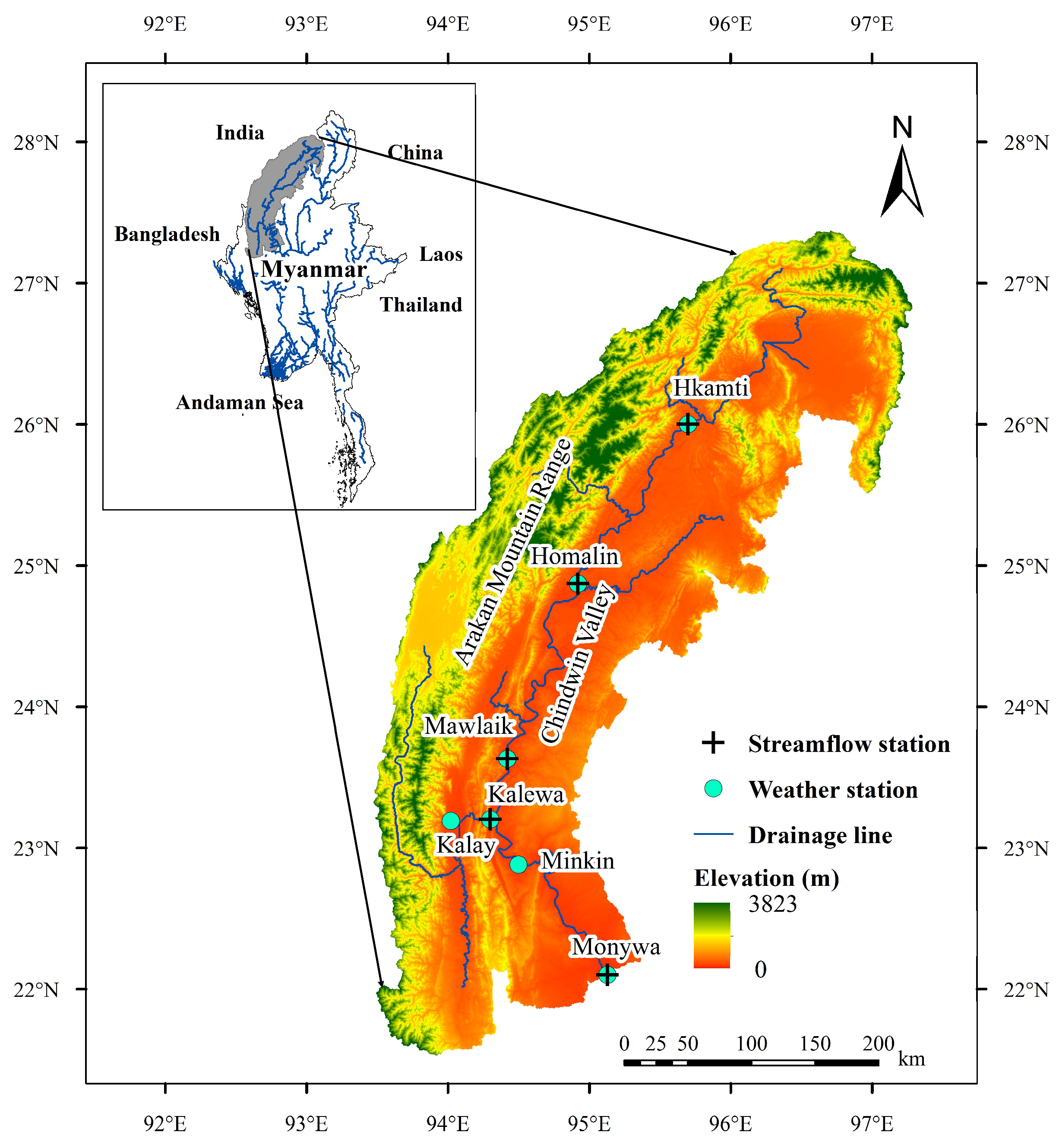
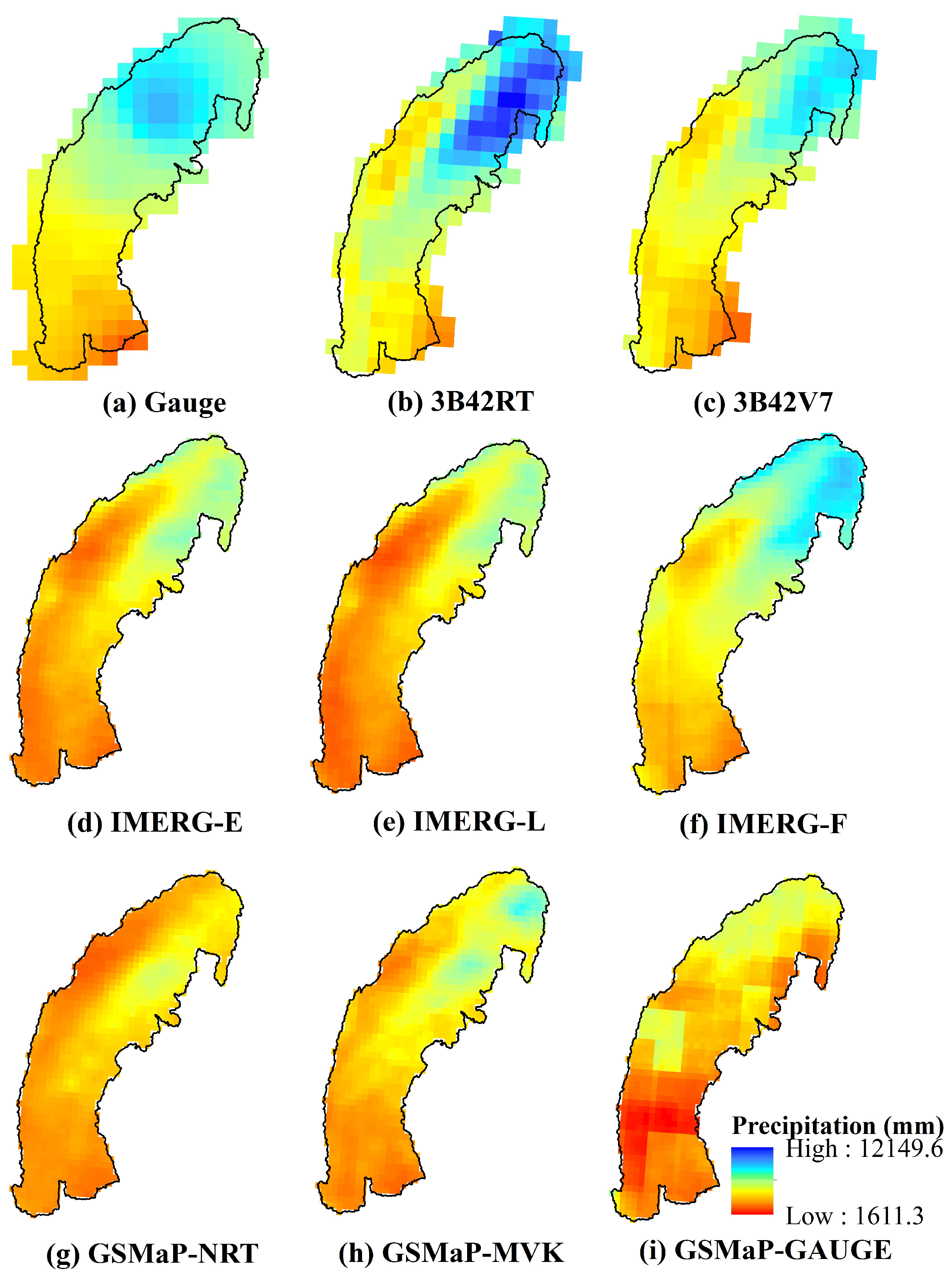
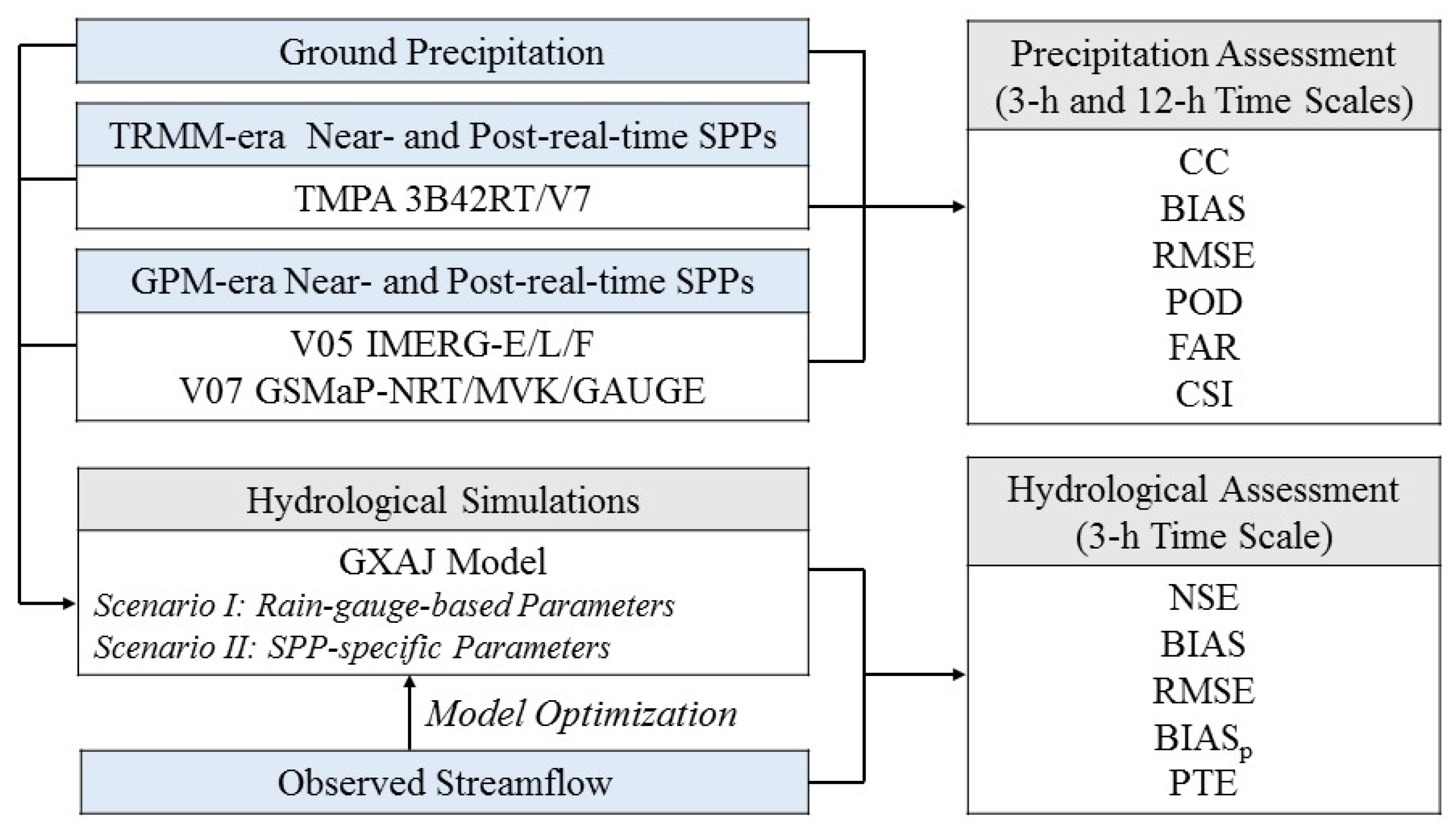
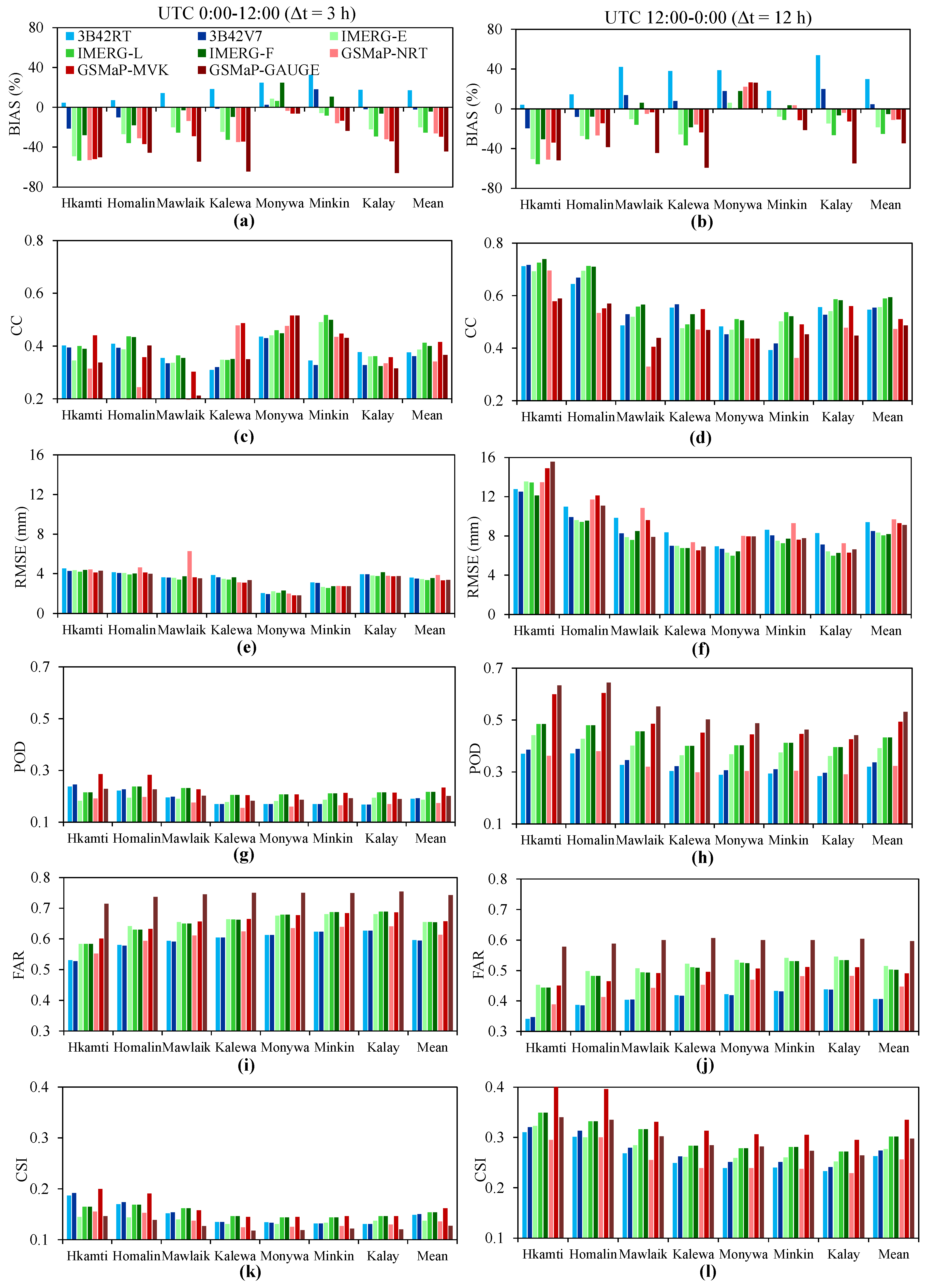

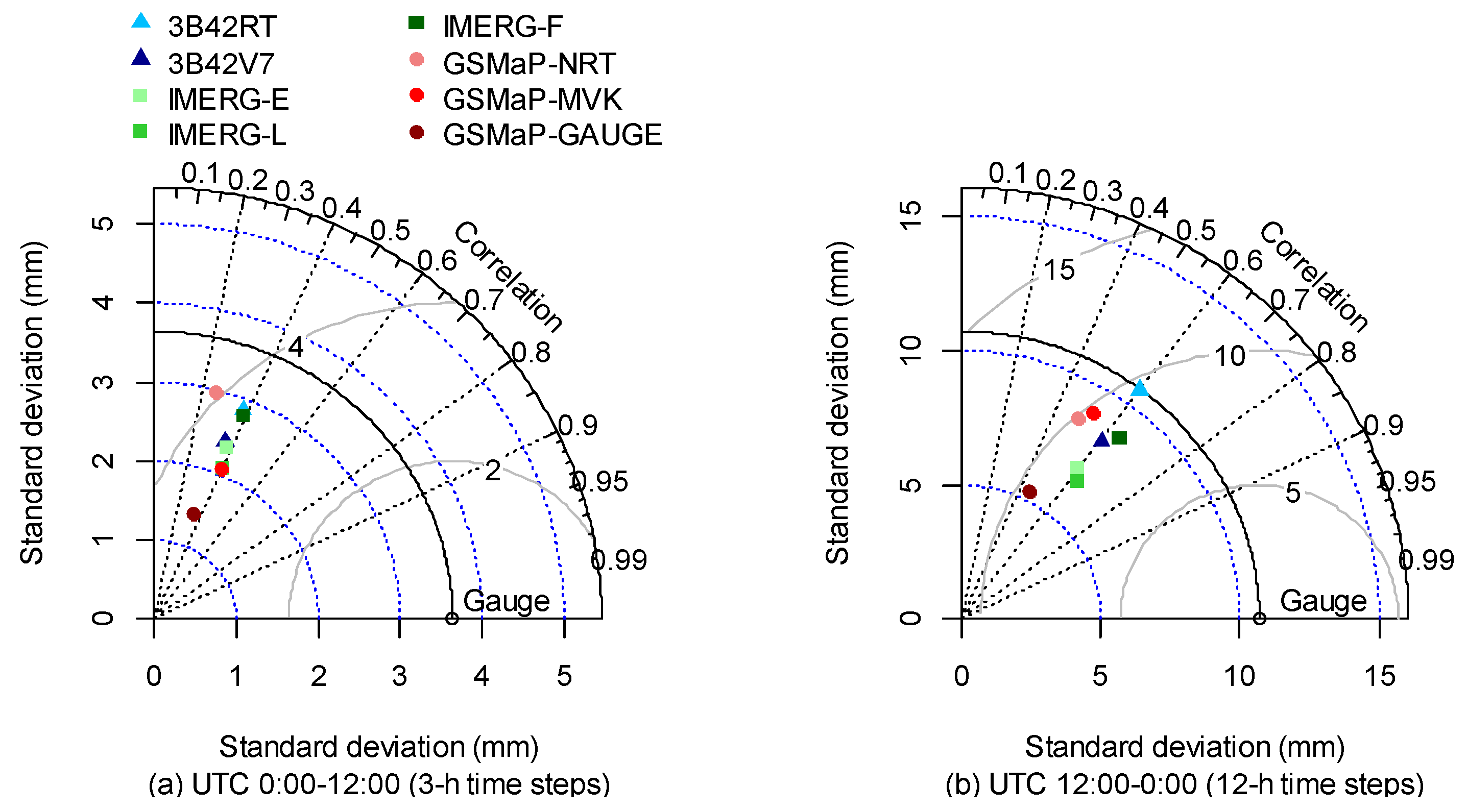
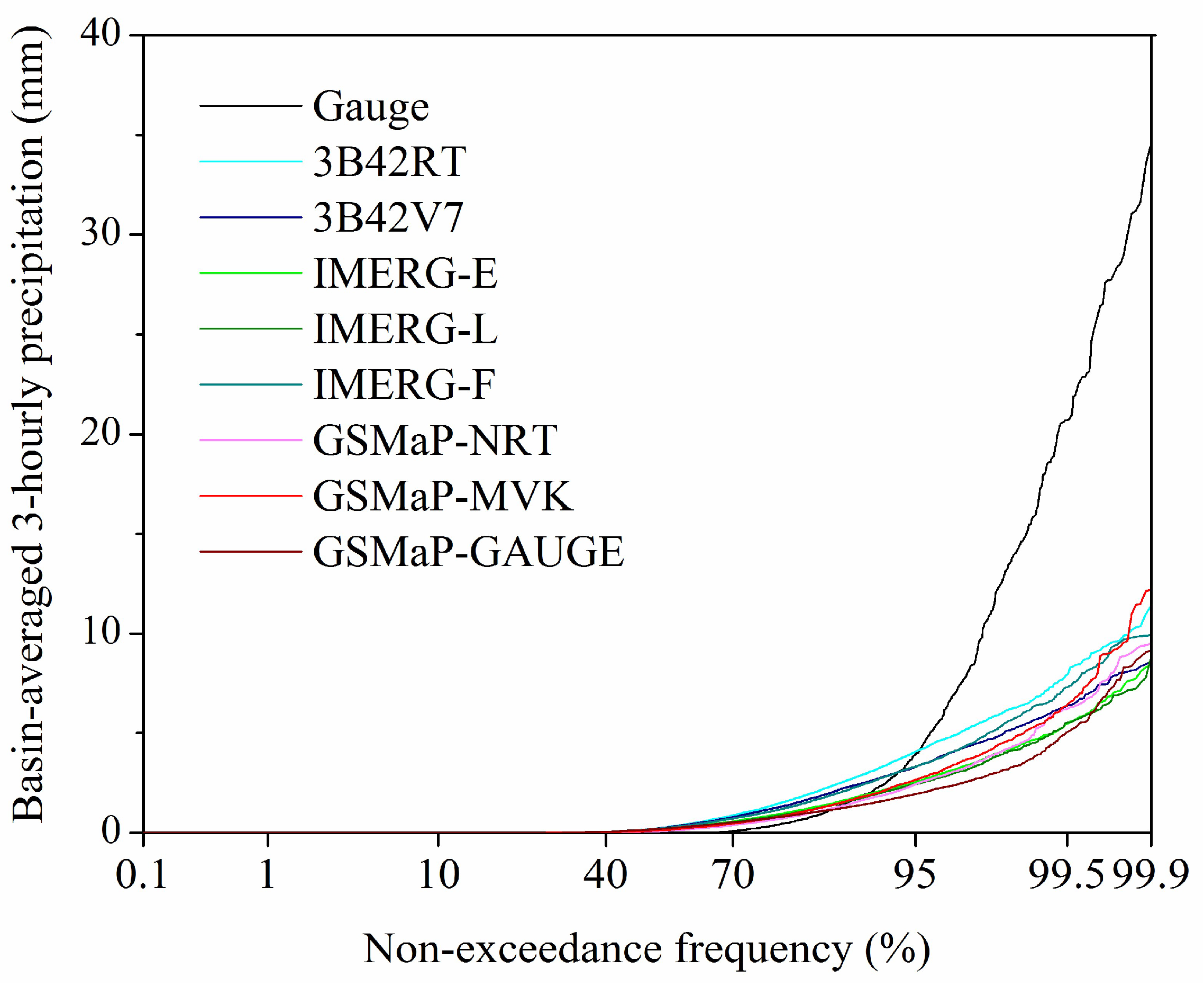
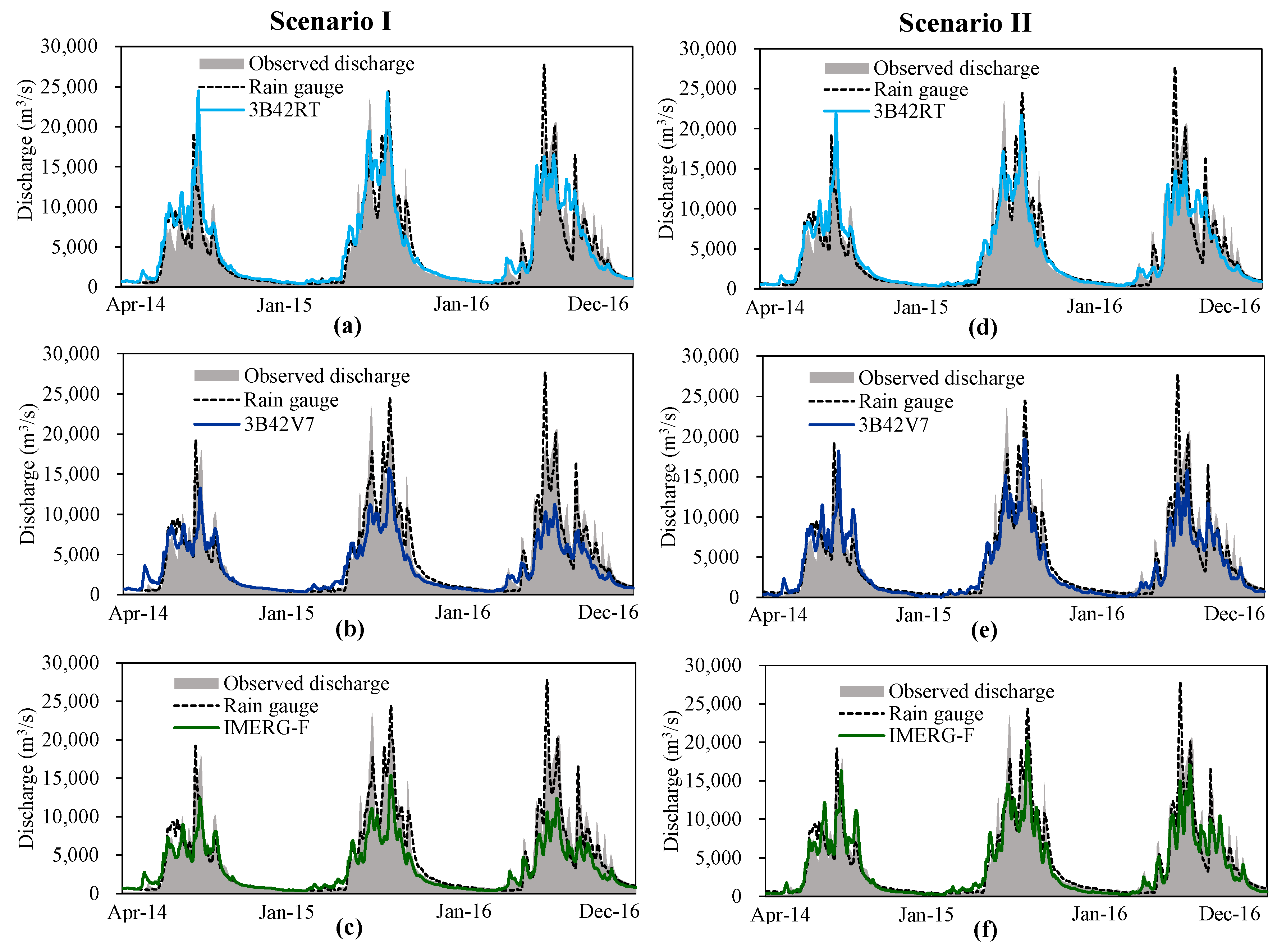
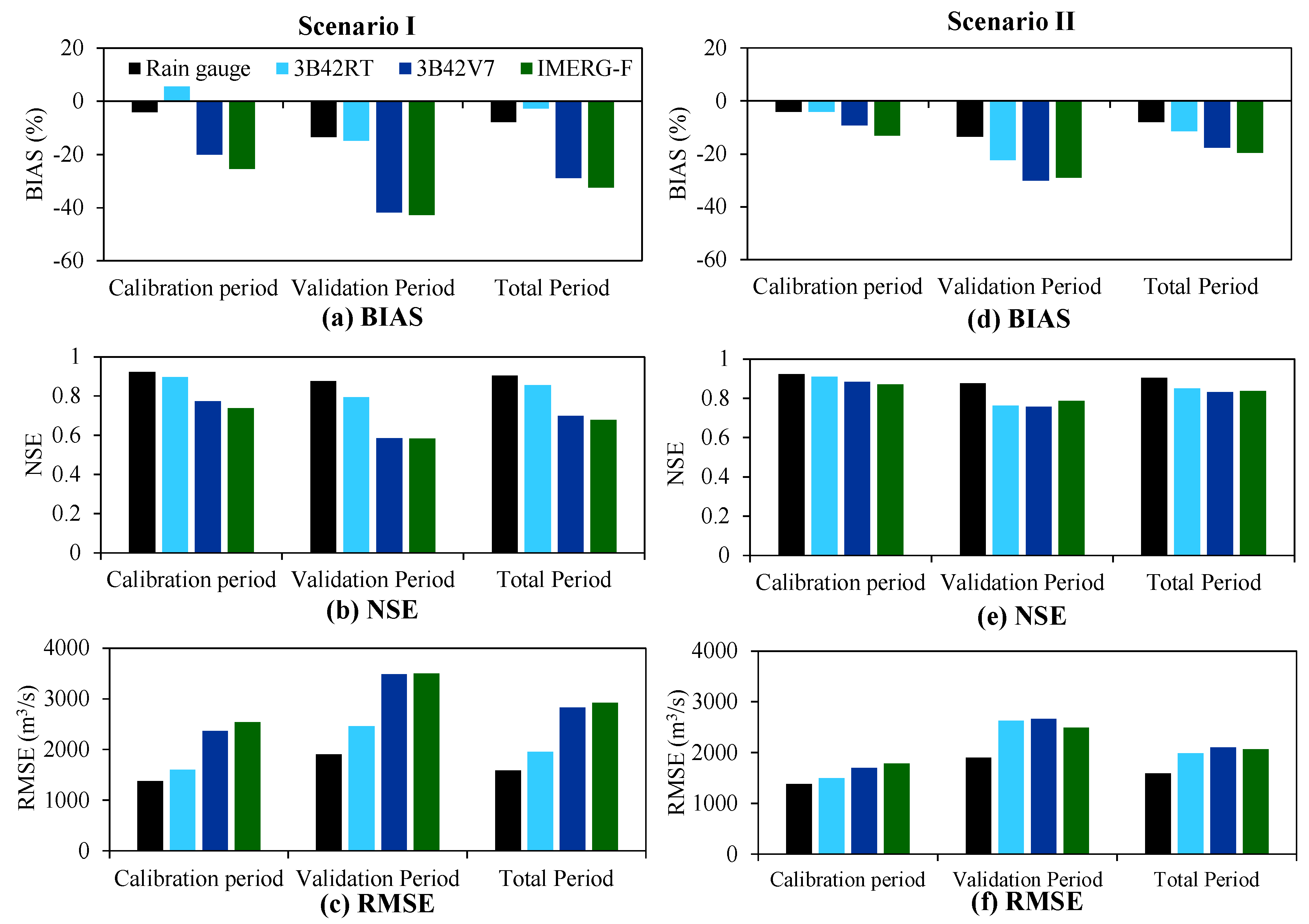
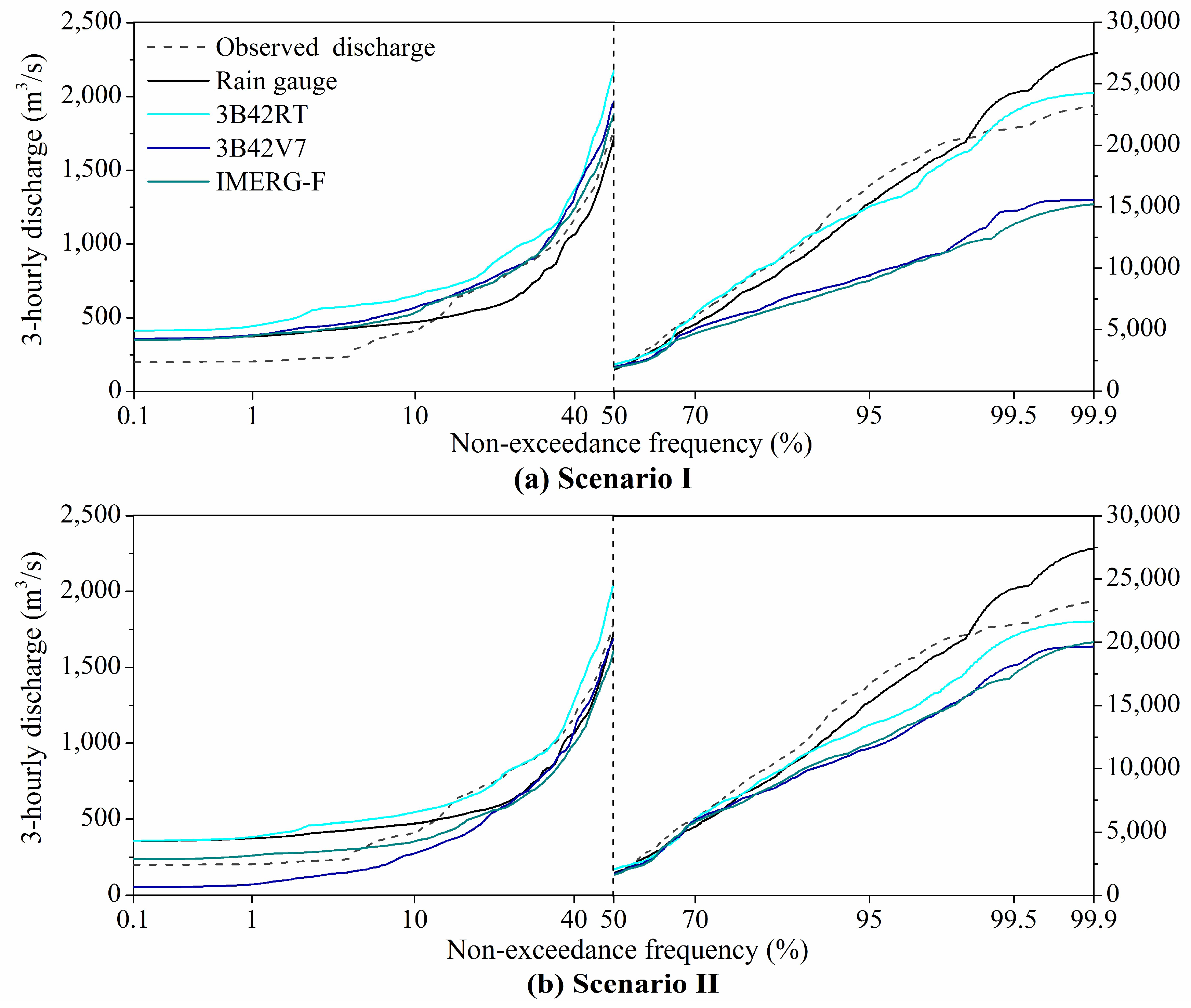
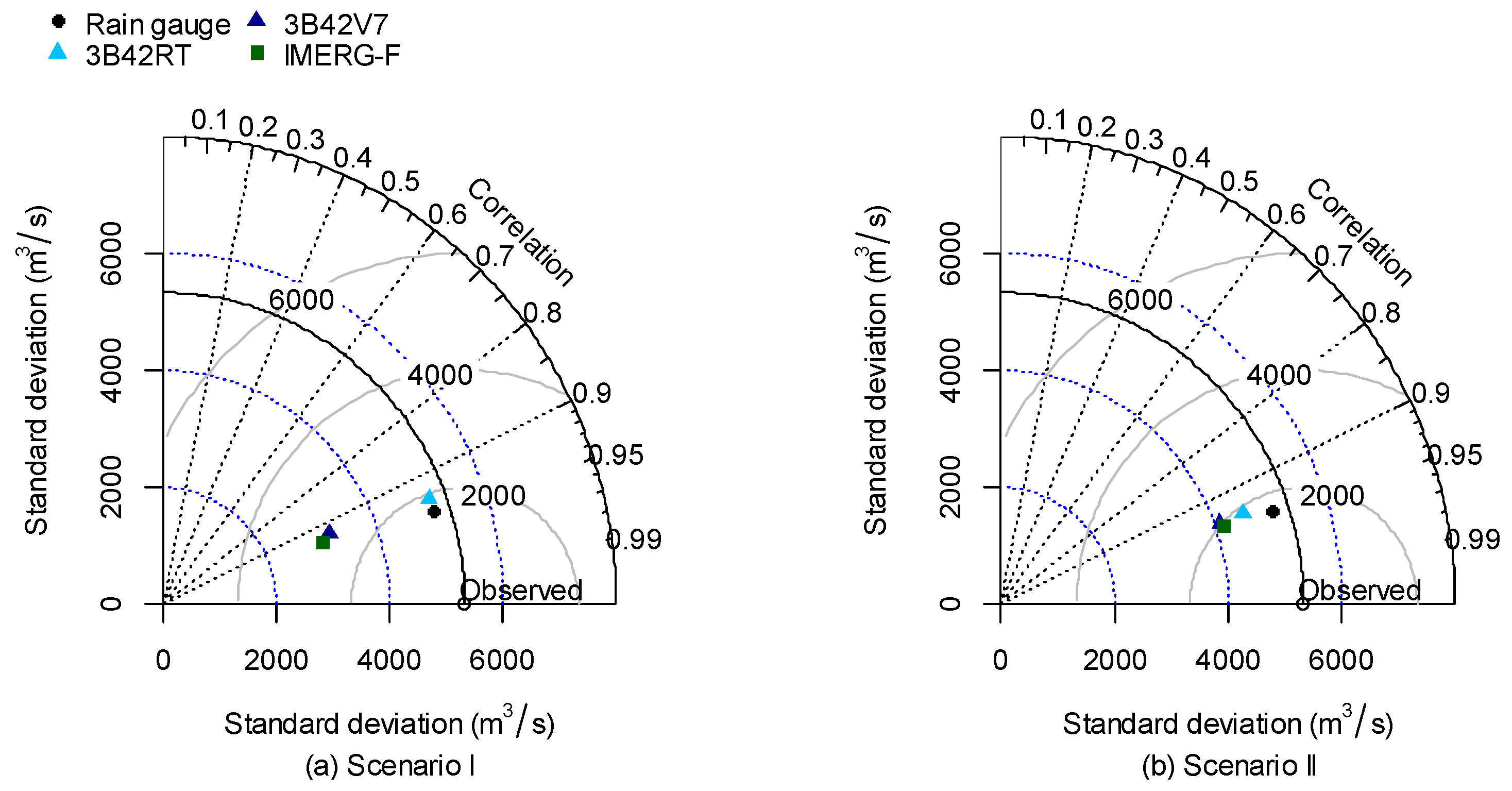
| Satellite Precipitation Products | Diagnostic Statistics | ||
|---|---|---|---|
| BIAS (%) | CC | RMSE (mm) | |
| 3B42RT | 11.1 | 0.281 | 3.0 |
| 3B42V7 | −4.8 | 0.277 | 3.0 |
| IMERG-E | −27.0 | 0.323 | 2.9 |
| IMERG-L | −30.6 | 0.319 | 2.9 |
| IMERG-F | −6.8 | 0.330 | 2.9 |
| GSMaP-NRT | −37.6 | 0.232 | 3.0 |
| GSMaP-MVK | −28.7 | 0.211 | 3.1 |
| GSMaP-GAUGE | −39.0 | 0.215 | 3.0 |
| Flood Events | Precipitation Inputs | Scenario I | Scenario II | |||||
|---|---|---|---|---|---|---|---|---|
| (m3/s) | (m3/s) | BIASp (%) | PTE (h) | (m3/s) | BIASp (%) | PTE (h) | ||
| 20140523 | Rain Gauge | 18,000 | 12,586 | −30.1 | −48 | – | – | – |
| 3B42RT | – | 24,471 | 36.0 | −15 | 21,852 | 21.4 | −9 | |
| 3B42V7 | – | 13,284 | −26.2 | −12 | 18,198 | 1.1 | −6 | |
| IMERG-F | – | 12,424 | −31.0 | −9 | 16,385 | −9.0 | −9 | |
| 20150803 | Rain Gauge | 23,500 | 17,818 | −24.2 | 66 | – | – | – |
| 3B42RT | – | 19,478 | −17.1 | −9 | 17,170 | −26.9 | −12 | |
| 3B42V7 | – | 11,201 | −52.3 | −24 | 15,208 | −35.3 | −27 | |
| IMERG-F | – | 11,073 | −52.9 | 15 | 14,576 | −38.0 | −36 | |
| 20150908 | Rain Gauge | 21,550 | 24,432 | 13.4 | 24 | – | – | – |
| 3B42RT | – | 24,257 | 12.6 | −30 | 21,672 | 0.6 | −18 | |
| 3B42V7 | – | 15,711 | −27.1 | −21 | 19,677 | −8.7 | 15 | |
| IMERG-F | – | 15,347 | −28.8 | 24 | 20,181 | −6.4 | 18 | |
| 20160803 | Rain Gauge | 20,660 | 20,162 | −2.4 | −36 | – | – | – |
| 3B42RT | – | 16,499 | −20.1 | −75 | 15,999 | −22.6 | −63 | |
| 3B42V7 | – | 11,229 | −45.7 | −72 | 15,845 | −23.3 | −69 | |
| IMERG-F | – | 12,387 | −40.0 | −66 | 17,096 | −17.2 | −63 | |
© 2019 by the authors. Licensee MDPI, Basel, Switzerland. This article is an open access article distributed under the terms and conditions of the Creative Commons Attribution (CC BY) license (http://creativecommons.org/licenses/by/4.0/).
Share and Cite
Yuan, F.; Zhang, L.; Soe, K.M.W.; Ren, L.; Zhao, C.; Zhu, Y.; Jiang, S.; Liu, Y. Applications of TRMM- and GPM-Era Multiple-Satellite Precipitation Products for Flood Simulations at Sub-Daily Scales in a Sparsely Gauged Watershed in Myanmar. Remote Sens. 2019, 11, 140. https://doi.org/10.3390/rs11020140
Yuan F, Zhang L, Soe KMW, Ren L, Zhao C, Zhu Y, Jiang S, Liu Y. Applications of TRMM- and GPM-Era Multiple-Satellite Precipitation Products for Flood Simulations at Sub-Daily Scales in a Sparsely Gauged Watershed in Myanmar. Remote Sensing. 2019; 11(2):140. https://doi.org/10.3390/rs11020140
Chicago/Turabian StyleYuan, Fei, Limin Zhang, Khin Min Wun Soe, Liliang Ren, Chongxu Zhao, Yonghua Zhu, Shanhu Jiang, and Yi Liu. 2019. "Applications of TRMM- and GPM-Era Multiple-Satellite Precipitation Products for Flood Simulations at Sub-Daily Scales in a Sparsely Gauged Watershed in Myanmar" Remote Sensing 11, no. 2: 140. https://doi.org/10.3390/rs11020140
APA StyleYuan, F., Zhang, L., Soe, K. M. W., Ren, L., Zhao, C., Zhu, Y., Jiang, S., & Liu, Y. (2019). Applications of TRMM- and GPM-Era Multiple-Satellite Precipitation Products for Flood Simulations at Sub-Daily Scales in a Sparsely Gauged Watershed in Myanmar. Remote Sensing, 11(2), 140. https://doi.org/10.3390/rs11020140




